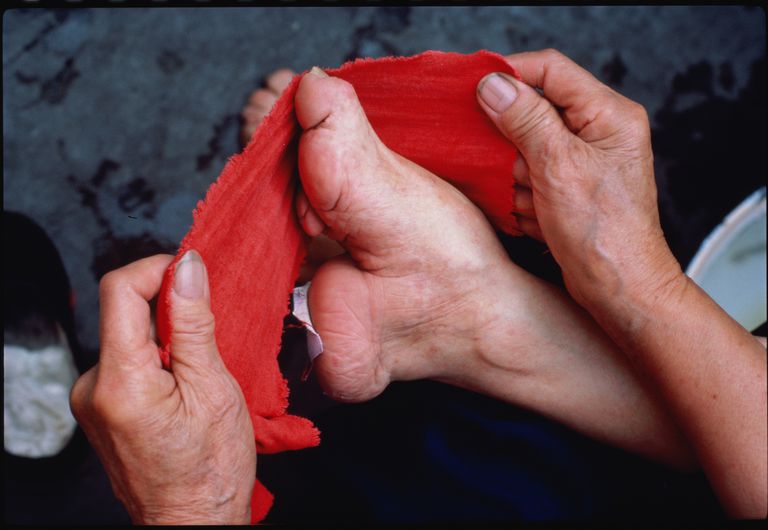Female genital mutilation, although common, is not the only violent and invasive culture that women are subject to. Up until the early 20th century, foot binding was a popular practice in many regions of China. By the late 19th century, about 50% of Chinese women in general, had their feet bound and 100% of Chinese women from a upper social class had their feet bound.

Article Content
What is foot binding?
Foot binding was a Chinese custom of binding the feet of young girls in order to modify the shape and size of their feet. The feet of a woman was considered to be a mark of beauty and a symbol of higher social class. The goal of foot binding was to make the feet of young girls smaller (usually to about 4 inches) and this involved the painful process of breaking the feet and binding them tightly in bandages. Feet that were bound were called lotus feet, named after the lotus and the special shoes made for these feet were known as lotus shoes.
Origin of foot binding
The exact origin of foot binding is not certain and there are a lot of stories that offer an explanation for its origin. One of these is the story of Pan Yunu, who was renowned for having delicate feet. One day, she danced barefoot on a floor decorated with the design of a golden lotus. The emperor was so impressed by her performance that he exclaimed that “lotus springs from her every step”. There is no record that indicates that Pan Yunu had her feet bound.
Another story is that Li Yu, the 10th century Emperor built a tall golden lotus that was 6 feet tall and decorated with pearls and precious stones. Then he asked his concubine, Yoa Nang, to dance on the points of her feet on the lotus after binding her feet in white silk. Her dance was so graceful that people tried to imitate her and the practice of binding the feet began to spread.
The process of foot binding
The process of foot binding was more gruesome than the name suggests. It was usually started in Chinese girls of young age (4-9) because their feet were not yet fully developed. The process was usually carried out by an older female relative and started during the winter months as the feet was likely to be numb from the cold, making the pain more tolerable. The foot to be bound was first soaked in a warm mixture of animal blood and herbs to soften the foot. Bandages for binding were also soaked in this mixture. The toenails were clipped as short as possible and the toes were curled and pressed very tightly into the sole of the foot until the toes broke. Then the arch of the foot was broken and the ankle restructured to draw the foot down straight with the leg. Then the bandages were wound tightly and repeatedly in a figure – 8 movement starting at the inside of the foot, carried over the toes, under the foot and around the heel. This bandaging is done so tightly that the ball of the foot and the heel are drawn together and the girl could not move her toes at all. The bandages were sewn to prevent the girl from loosening them.
Dangers and health issues associated with foot binding
Unsurprisingly, foot binding was very dangerous and caused many health issues. First of all, it caused excruciating pain for these young girls all in the name of beauty and marriage value. The feet was also prone to infection and gangrene; in very serious cases, the infection affected the bone and caused the whole foot to fall off. 10% of women who had their feet bound died from gangrene. Women who had their feet bound had difficulty with balance and sometimes needed help getting up from chairs. Also, they couldn’t walk long distance or work in farms.
Tradition
The feet of a woman was seen as a mark of beauty and women with bound feet were considered more beautiful that women with unbound feet. Also, feet binding was a symbol of status – because it restricted movement, only rich families could afford to bind the feet of their daughters as they didn’t have to work in the fields. Some poor families would bind the feet of their oldest child to increase her chances of marrying into a rich family. Some men found the smell of a bound foot erotic and some believed that bound feet caused extra folding in a woman’s vagina making sex more pleasurable. Because of the change in size and shape of the feet after binding, women with bound feet had a special gait that involved bending their knees and bearing most of their weight on their heels. This gait was considered feminine and even erotic.
The practice of foot binding ended in the 20th century and presently, there are only a few (elderly) women in China who have their feet bound.
Read Also: 5 Ways In Which Women Are Oppressed Without Knowing

Chisom Anastasia Nwaezuoke is a physiotherapist, writer, public speaker and yogi. She is also a sexual health and reproductive rights advocate and volunteers for HandsOff Initiative.
